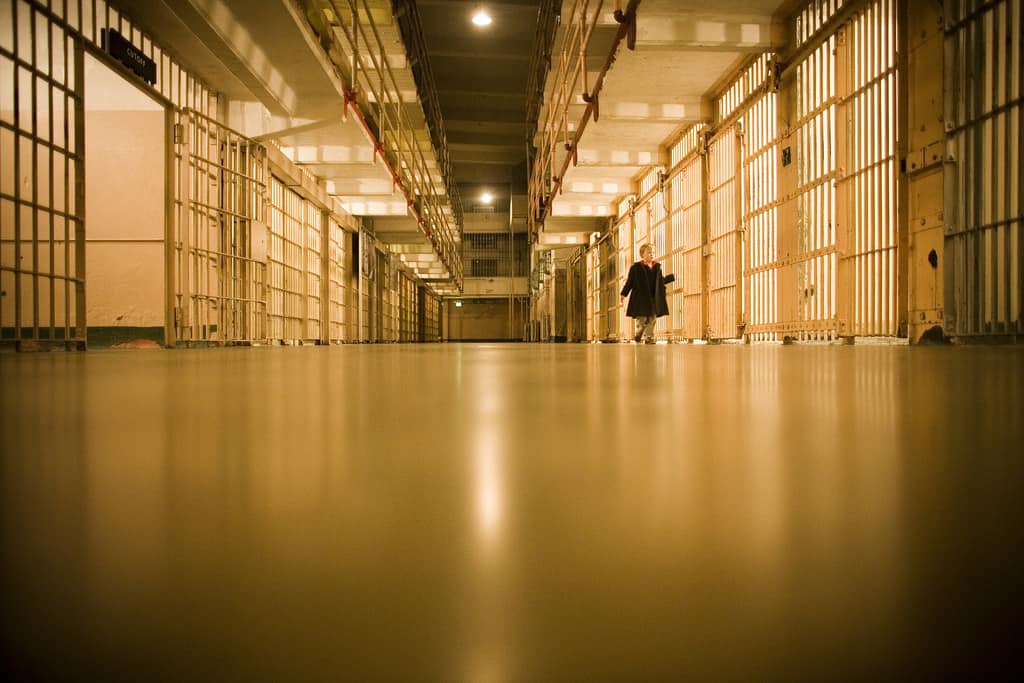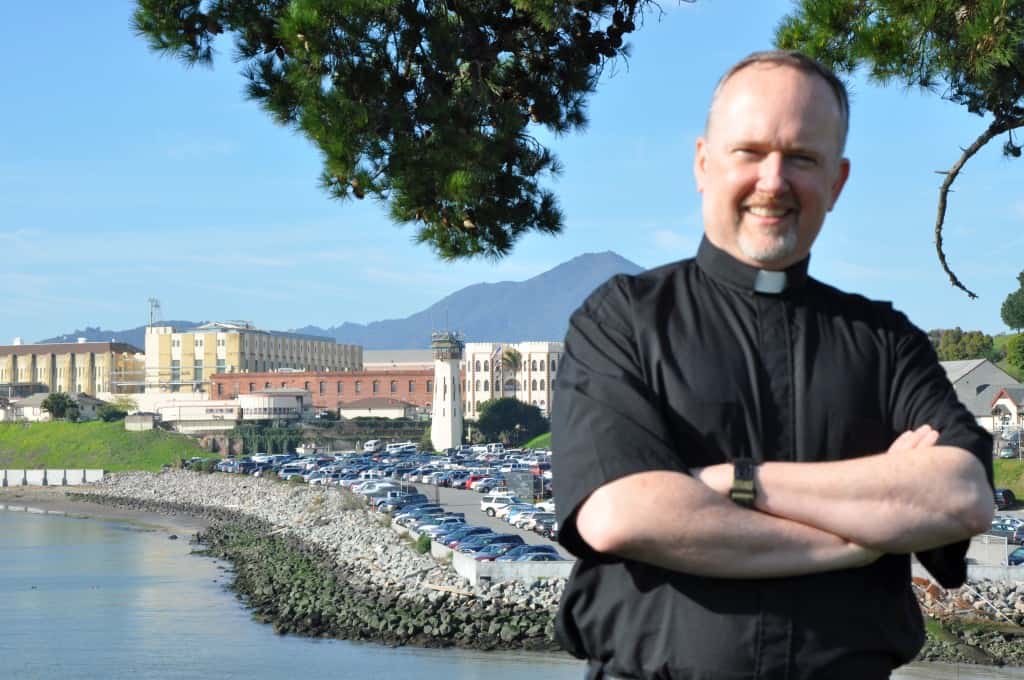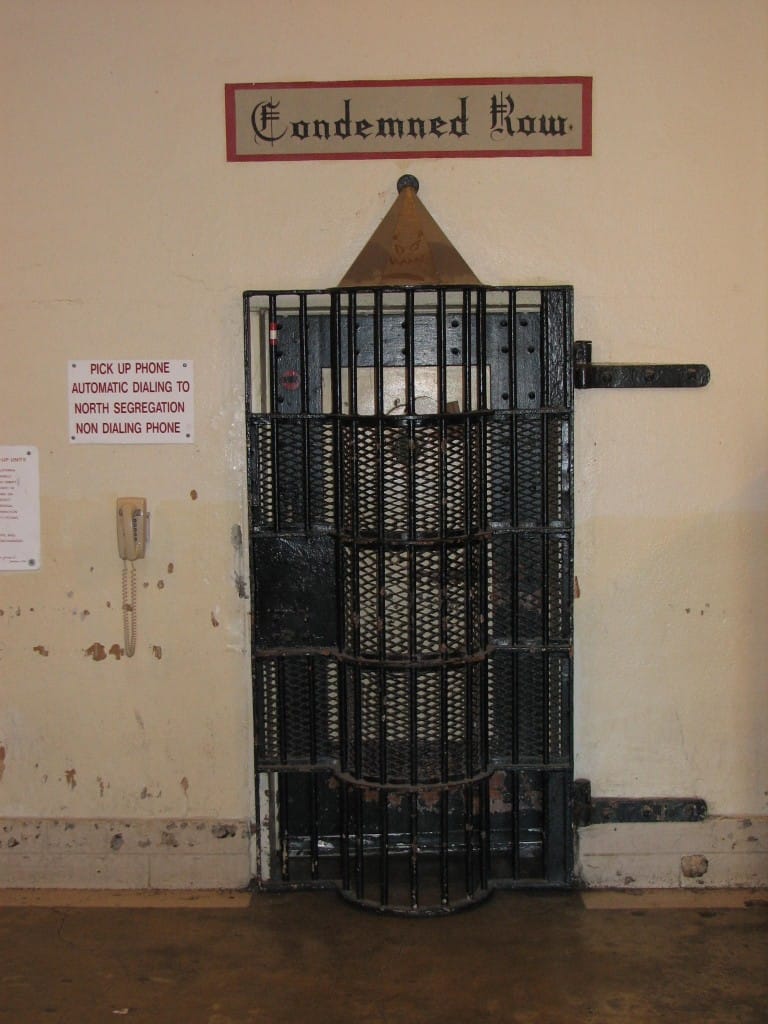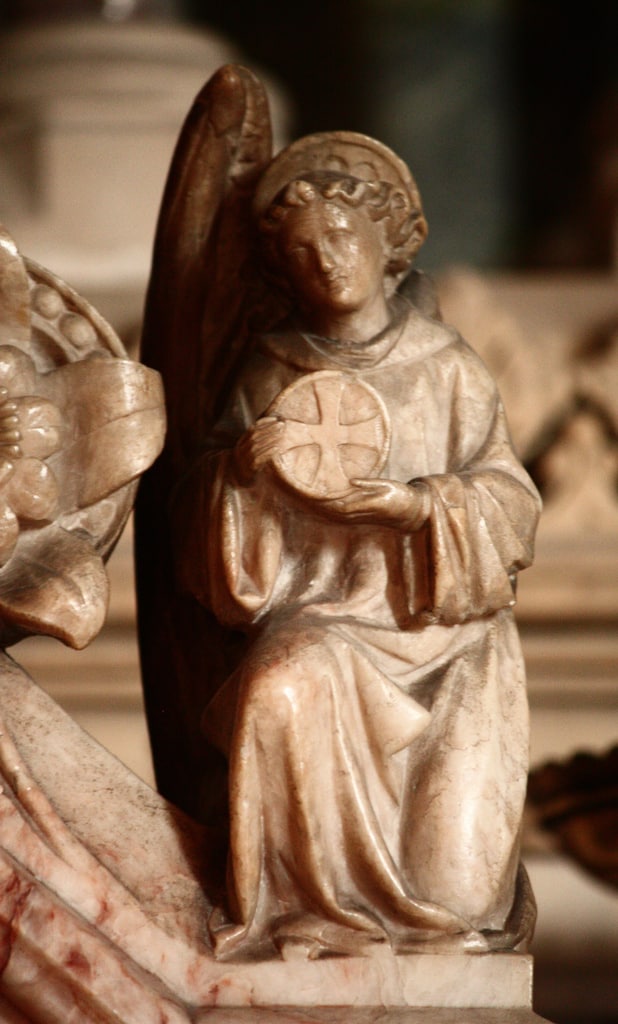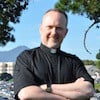“For this is my body, which will be given up for you.”
Saying these words, I lift up the host for the men inside the cage to see.
The “chapel” in San Quentin State Prison’s Death Row is a windowless old shower room encased in a heavy metal cage. Inside it there are 6 wooden benches bolted to the floor upon which the members of my congregation sit. I stand, wearing both priestly vestments and a black stab-proof vest, inside my own cage, which is about twice the size of an old phone booth. As required by the department I have padlocked myself inside. All this makes me, to my knowledge, the only Jesuit in my community who regularly celebrates Mass in a Kevlar vest.
There is a harsh florescent light overhead, and as I raise the consecrated host the light illuminates it. I look past the host to the men in the cage. They are quiet and focused. It’s at this point of the Mass that I often imagine, as I am standing there facing them, separated by the steel mesh, that the light of Christ is streaming forth from that host, dispelling the dark shadows of “East Block” – San Quentin’s Death Row for men.
***
There are 725 men currently condemned to death in the state of California – all of them housed at San Quentin.1 I work as the Catholic chaplain on the largest Death Row in the United States, possibly the Western Hemisphere. Some of these men have called Death Row home for over 30 years; since the death penalty was reinstated in California in 1972. Executions were resumed that year by Proposition 17, a voter initiative that amended the state’s constitution, overturning previous court decisions that had found capital punishment unconstitutional. In the past 30 years far more men have died of old age (or from suicide) on San Quentin’s death row than the 13 who have been put to death by the state. Their hopelessness and despair linger in the shadows long after the bodies are wheeled out.
It is a building of many, many shadows. Visitors invariably comment on how eerie and dark the place looks and feels. The 12-foot high black doors at the entrance of the building, above which the words “CONDEMNED ROW” are written in calligraphic lettering, don’t help. Inside those doors an almost palpable air of oppression broods over the place. There are plenty of ghosts too.
Walking onto Death Row one is at first taken aback by the size of the place. As long as a city block, 5 floors (or tiers) high, the place looks like some kind of huge warehouse. There are windows that are so dirty that they are practically opaque. They let in a yellow light that does nothing to brighten the cavernous and lifeless space. There are 50 cells to each tier, so, standing at the bottom, you ought to be able to see 250 prison cells spread out in front of you. But you cannot, because the cells of the top two tiers cannot be seen from the ground level. The view is blocked by a wall of gray and black metal.
Death Row, perhaps surprisingly, is not very noisy. The loudest (and most annoying) noise is the incessant intercom at the guard’s station calling the Tier Officers to bring inmates to and from visits, medical appointments, or the shower. The concrete and metal walls trap the intercom’s sound, echoing it back and forth.
One set of cell-fronts face east, toward the Bay that cannot be seen for the dirty windows. The other 250 cells face “the Yard” – a World War II-era, rusting, corrugated-metal-roof structure housing a dozen large free-standing cages that look like kennels. It is inside these cages that the men on “walk-alone” status go to “recreate” for a few hours each week. These men are on “walk alone” status because they have shown themselves too dangerous to mix with other prisoners. It is these who are, in the main, responsible for the frequent stabbings and assaults that occur within a group of men who have nothing else to lose and who live in a tiny world of petty gossip and verbal abuse. Every man there has told me, at one point or another, that the worst part of his life on Death Row is loneliness. I have been surprised, during these same conversations, to learn that not all of the men on Death Row are against the death penalty. Some would welcome it.
Each man has his own cell. Windowless, fronted by the same kind of heavy metal mesh, a barred door and a food slot with a cover that is padlocked shut most of the time, each cell measures 5 feet wide by about 10 feet deep. The cells are dark and cramped. At the back of the cell, at about eye level, there is a shelf, below it a stainless steel toilet with a stainless steel sink built into the top of it. A small, round metal stool is built into one wall, and in front of the stool is a bed. Most of the men take the thin, 1-inch thick cotton mattress and put it on the floor to sleep. They use the flat metal platform of the bed as a desk instead. All the men have small televisions, which are always on, and which provide them their only view of the outside world.
Death Row smells like a locker room mixed with a cafeteria mixed with an outhouse. As you walk past the cells, the smell of a recent bowel movement blends nauseatingly with the smell of a neighbor cooking rice and beans in a hot pot.
***
“This is my body which will be given up for you.”
These words were spoken at the last meal of a man about to be condemned by the state and executed. It’s strange how the words of the Gospel take on a different resonance on Death Row. Jesus, the executed prisoner, reflected in the eyes of men also sentenced to die. I know Jesus was innocent, and I know what these men have done to earn their cells and sentences. It took some doing on their part. It often took horrible, brutal crimes; the stuff of horror movies and nightmares. Over 100 of these men tortured their victims before killing them. Nearly 200 molested and killed children.
But as I raise the host I don’t see heinous murderers standing in front of me, I see human beings. And if His body were not given up for them too, then what difference would our religion make? The fact that His love reaches down into this pit of hell is what gives my life its meaning and purpose. I am often moved to tears at this part of the Mass, the part where it dawns on me again what a gift I have been given to be able to stand there and bear witness to the mercy of Christ embodied in this sacrament in such a dark place.
At the Sign of Peace we shake hands through our cages. This is the only point of physical contact with these men – they reach their hands through a 4×12 inch slot in the mesh wall to shake mine. I am often surprised at the way they grasp my hand – there is so little human touch on Death Row. In some ways, it feels to me like they are trying to grab hold of a different reality than the cold and lifeless place they live in. The handshake of a serial killer, a child-molester, a torturer feels the same as any other handshake.
***
There are moments of (admittedly dark) humor too. Recently, one of my serial killer parishioners said to me, “Now Father, don’t do anything I wouldn’t do!” This is no doubt the best advice I’ve received from a serial killer to-date.
It might seem strange to you, reading this, that I love this work. But I do. I feel it is the best ministry I could ever do; that I wouldn’t trade it for tenure at Harvard. Seriously. When I leave the prison, or when I’m driving in to work over the Richmond Bridge with the breathtakingly beautiful Bay to my left, I feel like I must be dreaming to work at a place so charged with the power of the Gospel.
But if there is any drawback for me about this work it is well-summed in the words of Dr. Martin Luther King, Jr., who, in Stride Toward Freedom, wrote: “He who accepts evil without protesting against it is really cooperating with it.” Am I cooperating with evil by working in a system that I believe to be – in a very real sense – demonic? If the California voters act foolishly and fail to abolish the death penalty this November, how will I deal with the prospect of having to accompany some of these men I have come to know to their executions? Is my work on Death Row somehow being complicit in state murder?
Ultimately I don’t think so. But, over many years of working in prisons and doing prison ministry, I have come to believe that prisons themselves are a mistake. I believe that they do far more harm to both prisoners and society than any purported good other than incapacitating and warehousing human beings.
The United States of America is now the prison capital of the world. We incarcerate a higher proportion of our population than any other country on earth. (And, yes, that includes China). Structural and institutionalized racism lies behind the fact that, while blacks and whites commit crimes at an equal rate, one in five black men in America can expect to spend some time in prison in his life, while for white men the ration is one in thirty five.
So, no, my work in the prison does not mean I approve of prison. It means that I am going where the Church often is absent. If I don’t go, who will? I ask myself. There are not scores of priests banging on Wardens’ doors, begging to be hired as chaplains. I wish there were.
In the same way, if I were to choose to fight against prisons instead of going into them to minister to the prisoners (and the guards to some extent), what would I accomplish? Only my own exclusion. And I would never get to hold up the Blessed Sacrament as a sign of light and hope in a human hell. As a priest, I have come to see my work as one of resisting the evil of prison from the inside, where I find Christ living.
— — — — —
- There are 19 women condemned to death as well, but they are housed in another prison. ↩

